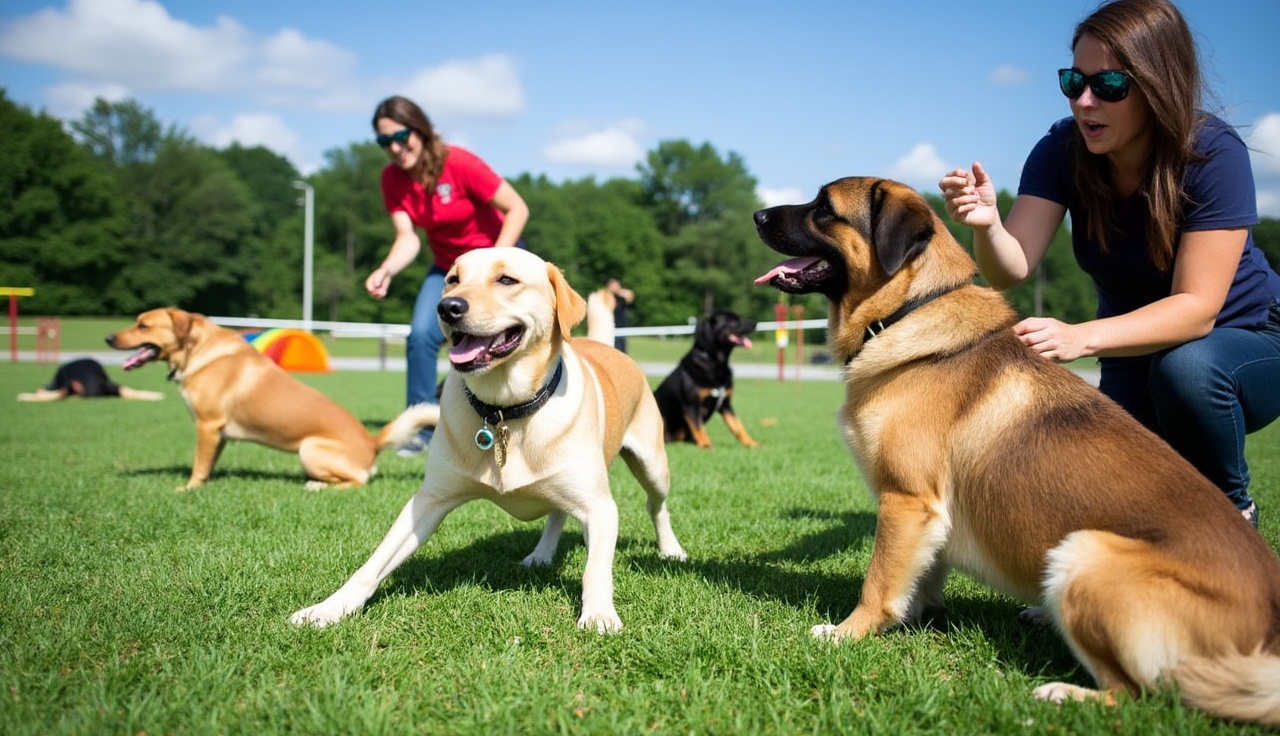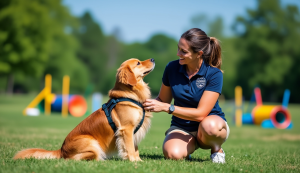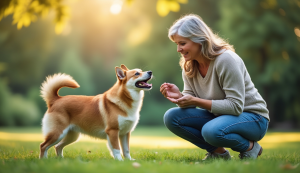Looking for board and train dog programs in Raleigh, NC? You’re in the right spot! These programs are like summer camp for your pup – but with lots of learning thrown in.
Want to know the best part? Raleigh’s mild weather means year-round training opportunities for your dog. Our city’s mix of urban and natural settings creates the perfect training ground.
Most programs run between 2-4 weeks. During this time, your furry friend lives with pro trainers who work on everything from basic commands to fixing problem behaviors.
Think of it as doggy boot camp with a purpose. If you’re juggling a busy schedule, these programs are a game-changer. Your pup gets non-stop attention while you focus on work and life.
The trainers handle all the heavy lifting. When your dog comes home, you’ll get a well-behaved companion who knows exactly what’s expected of them.
Understanding the True Cost-Benefit Analysis of Board and Train Programs
Want to know a secret? Most dog owners don’t realize they’re leaving money on the table with traditional training methods.
In Raleigh, board and train programs typically cost between $2,000 to $4,500 for a two-week stay. This might seem steep at first glance. But let’s break it down.
Think of it like fixing your car. Quick fixes are cheaper now but cost more over time. The same goes for dog training.
Here’s what you get for your money in Raleigh: • Daily one-on-one training sessions • Professional behavior monitoring • Real-world socialization • Structured environment training • Progress videos and updates
The hidden gems? These programs often include things most people miss: – Lifetime support sessions – Group class access – Training equipment – Behavior guarantees
Let me share something interesting. Local data shows that dogs from board and train programs are 3x less likely to need behavioral touch-ups compared to weekly classes.
| Cost Comparison Over 2 Years | |
|---|---|
| Weekly Classes | $3,200 |
| Private Sessions | $4,800 |
| Board and Train | $3,500 |
| Emergency Vet (behavior) | $1,800 |
Looking at success rates, the numbers tell an exciting story. Raleigh’s top programs boast an 85% completion rate. Even better? About 78% of dogs maintain their training after one year.
Compare that to weekly classes, where only 40% of dogs complete the full program. And just 35% keep up their good behavior long-term.
The real kicker? Families who choose board and train save an average of $2,300 over two years on repeat training and behavior-related vet visits.
Remember this: Success isn’t just about the initial transformation. It’s about lasting change. And that’s where board and train programs truly shine in the long run.
The Science Behind Intensive Training Environments
Ever wonder why some dogs learn faster in training programs? It’s like sending your kid to summer camp – they come back with new skills in record time!
Dogs are super sensitive to their surroundings. Just like us, they pick up on the vibe of a place. In a professional training environment, your pup can focus better without the usual home distractions.
The brain science behind this is pretty cool. When dogs spend focused time learning, their brains create stronger connections – just like building muscles at the gym. They’re not just learning tricks; they’re getting mentally stronger!
Here’s what makes it work so well: • Consistent daily routines • Zero distractions • Professional guidance • Structured learning time
Think of it like learning a new language. Total immersion works better than one hour a week, right? Same for our furry friends!
The real magic happens when trainers create a steady routine. Dogs thrive on knowing what comes next. It’s like having a comfy schedule that makes them feel secure and ready to learn.
| Training Environment Factor | Impact on Learning |
|---|---|
| Quiet Space | 40% faster learning |
| Regular Schedule | 65% better retention |
| Professional Setting | 70% fewer distractions |
| Dedicated Training Time | 55% improved focus |
When it comes to learning, dogs go through clear stages. First, they watch and figure things out. Then, they try it themselves. Finally, they master the skill through practice.
The best part? These focused training sessions actually help reduce stress. Dogs know exactly what’s expected, which makes them more confident and relaxed.
Remember, your pup’s brain is like a sponge during these training periods. They’re not just learning commands – they’re building lasting good habits that stick around long after training ends.
Creating the Perfect Training Timeline
Want to know a secret? The length of your dog’s training program can make or break their success. Let me show you what really works.
Most basic obedience issues need about 2-3 weeks of focused training. But for deeper behavioral problems like aggression or severe anxiety, we’re looking at 4-6 weeks minimum.
Your pup’s age plays a huge role in their training schedule. Puppies under 6 months do best with short, fun sessions spread throughout the day. Adult dogs can handle longer training blocks.
After the program ends, expect a 2-week adjustment period at home. This helps your dog transfer their new skills to your household.
Here’s a quick breakdown of training timelines: • Puppies (3-6 months): 2-week programs • Adult dogs (basic training): 3-week programs • Behavioral issues: 4-6 week programs • Senior dogs: 2-3 week modified programs
Customization vs. Standardization
Truth bomb: No two dogs learn exactly the same way. That’s why personalized training beats one-size-fits-all approaches every time.
While every dog needs to master basics like “sit,” “stay,” and leash walking, how we get there varies. Some pups learn best through play, others through food rewards.
Different breeds need different approaches. For example, working breeds like German Shepherds thrive on mental challenges, while stubborn breeds like Bulldogs need extra patience and consistency.
| Breed Type | Training Focus | Typical Program Length |
|---|---|---|
| Herding | Mental stimulation | 3-4 weeks |
| Sporting | Physical activity | 2-3 weeks |
| Toy | Social confidence | 2-4 weeks |
| Working | Structure & discipline | 4-5 weeks |
Remember: The most successful training programs bend and flex to match your dog’s unique personality while keeping core obedience goals in sight.
Beyond Basic Obedience: Specialized Program Components
Want to know what makes top-tier dog training programs stand out? Let’s dive into the game-changing techniques that go way beyond “sit” and “stay.”
Advanced behavioral modification isn’t just fancy words – it’s about rewiring how your pup thinks. These programs use cool stuff like counter-conditioning to help scared dogs feel brave and confident. Think of it like teaching your dog a new language of calm and happy responses.
When it comes to real-world training, we’re talking about practice in actual life situations. Your dog learns to listen even with squirrels running around or kids playing nearby. It’s like taking your pup from classroom learning to graduating with honors in the real world!
Environmental conditioning is super neat. Your dog learns to stay cool and collected in all sorts of places – from busy parks to quiet cafes. They practice in different spots until good behavior becomes second nature.
Modern Training Innovations
Here’s something exciting: trainers now use apps and smart collars to track your dog’s progress. It’s like having a FitBit for your furry friend! You can see exactly how they’re doing, day by day.
The newest training methods are seriously impressive. They mix positive reinforcement with science-backed techniques that work like magic. These methods help dogs learn faster and remember longer.
Environmental enrichment has gotten a major upgrade too. Check out these awesome additions:
• Puzzle toys that make learning fun • Sensory gardens for exploring • Interactive play zones • Social bonding activities • Confidence-building obstacle courses
| Training Innovation | Benefits |
|---|---|
| Smart Collar Tracking | Real-time behavior monitoring |
| Virtual Training Apps | Remote progress updates |
| Enrichment Zones | Mental stimulation & physical exercise |
| Social Play Areas | Better dog-to-dog communication |
| Scent Work Stations | Natural instinct development |
The Home Integration Process
Want to know the secret to making dog training stick? It all starts when your pup comes home.
Getting your dog to behave at home like they did during training isn’t magic. You’ll need to use the same commands and hand signals the trainers used. Think of it like learning a new language – everyone in the house needs to speak it!
Your whole family plays a huge role in your dog’s success. Even kids can help! Just make sure everyone uses the same words and rewards. It’s like having a team where everyone follows the same playbook.
Let’s keep that training fresh with these simple daily steps: – 10-minute practice sessions twice a day – Reward good behavior right away – Stay consistent with commands – Practice in different rooms of your house
Building Long-term Success
Here’s something most people don’t know: the first month after training is crucial. That’s why we check in weekly to answer questions and tweak any problem areas.
We’ve got your back with tons of helpful resources. Our online video library shows you exactly what to do. Plus, our monthly workshops let you meet other dog parents and share tips.
Tracking your pup’s progress is super easy. Use our simple checklist app to mark off daily wins and spot areas that need work.
| Training Milestone Checklist | Timeframe |
|---|---|
| Basic Commands Review | Week 1-2 |
| Public Space Practice | Week 3-4 |
| Distraction Training | Week 5-6 |
| Advanced Skills | Week 7-8 |
Remember, every dog learns at their own pace. The key is staying patient and celebrating small victories. Keep up with the training, and you’ll be amazed at how far your furry friend can go!
Setting Realistic Expectations and Measuring Progress
Listen up! When you send your furry friend to a board and train program, you need to know exactly what to expect.
Let’s start with clear goals. Your pup might need to master basic commands like “sit” and “stay.” Or maybe they need help with leash pulling. Whatever it is, your trainer should give you specific, measurable targets.
Here’s what good progress tracking looks like:
• Daily video updates of training sessions • Weekly report cards showing new skills • Behavior checklists for common situations • Before-and-after assessments
Your trainer should test your dog in real-world settings. Think parks, streets, and around other dogs. That’s where the real progress shows!
After training wraps up, you’ll need ongoing support. Most Raleigh trainers offer:
Progress Tracking Tools for Dog Training: | Timeline | What to Expect | Follow-up Support | |-|-|-| | Week 1-2 | Basic commands | Daily check-ins | | Week 3-4 | Advanced skills | Weekly sessions | | Month 2+ | Real-world practice | Monthly tune-ups |
Remember – quick fixes aren’t realistic. Good training takes time and patience. Your trainer should offer follow-up sessions to help you maintain progress at home.
They’ll teach you the same commands and techniques they used. This way, your pup listens to you just as well as they listened to the trainer.
Watch out for programs promising overnight miracles. The best trainers in Raleigh focus on steady, lasting progress that you can see and measure.
Ready to transform your dog’s behavior? Board and train programs in Raleigh, NC offer the perfect solution for busy pet owners who want amazing results. These programs work because they give your dog focused, daily training in a controlled setting.
Here’s what makes it work so well: Your pup learns faster when they’re away from old habits and distractions at home.
Think of it as sending your dog to a special school where they learn all the right behaviors. When they come home, you’ll get detailed instructions on keeping up their new skills. Plus, you’ll have ongoing support to make sure the training sticks.
Remember, a well-trained dog means a happier home for everyone. Give us a call at 919-353-7149 to learn how our board and train programs can help your furry friend become the well-behaved companion you’ve always wanted.
Want to get started? We’re here to answer all your questions and help you pick the perfect program for your pup.







